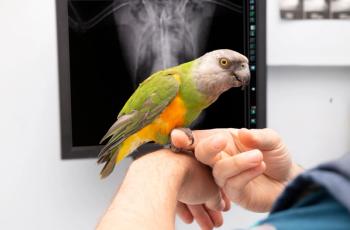
Therapy lasers: mechanism of action and current research (Proceedings)
Low-level laser therapy is emerging as a new treatment option with a variety of applications in the veterinary field.
Low-level laser therapy is emerging as a new treatment option with a variety of applications in the veterinary field. It is rare to discover a treatment modality that is non-invasive and well tolerated with no known side effects. Used by physicians in Europe for over thirty years, the low-level lasers also known as therapy lasers have recently gained approval from the FDA for certain human applications like non-surgical treatment of carpal tunnel symptoms and the control of myofascial pain.
The term LASER stands for light amplification by stimulated emission of radiation.
Einstein postulated the theory of light amplification in the early 1900's and the first laser was designed in 1960 by Theodore Miaman.
Laser diodes are made in a vacuum by combining certain elements. Photons are emitted when these elements are stimulated by electricity. Photons conduct changes in the body at the cellular level depending upon the tissue they contact. The first element used to emit laser light was the ruby. Examples of elements used in low-level lasers include the following:
Indium, gallium, aluminum, phosphorous-wavelengths of 630-685
Gallium, aluminum, arsenide-wavelengths of 780-870
Gallium and arsenide - wavelengths of 904-905
Helium, neon – wavelength of 632
Low-level lasers can be used alone or in combination with other pain management tools to decrease recovery time, help manage pain, and treat other conditions. Unlike cutting lasers which operate on 2-20 watts of power, low-level lasers operate on 1 watt of power or less utilizing a variety of wavelengths.
The tissue reaction variables with any type of laser need to be taken into consideration when delivering a treatment. These variables include:
- Laser class
- Laser wavelength
- Laser power
- Laser beam (focus/dispersion)
- Exposure or duration
- Variability of the tissue exposed
All lasers are classified by the FDA based on their safety to the eyes.
Class I- Lasers do no harm to the eyes
Class II- Momentary viewing of laser is not considered dangerous.
Class IIIa- Direct viewing may be dangerous
Class IIIb- Protective glasses must be worn
Class IV- Can cause serious injury to the eye and skin. Protective eye wear required.
Numerous studies show that low level lasers work at the cellular level. Wilden and Karthein (1998) found increased ATP production in mitochondria stimulated by low level laser. In the Journal Lasers in Medical Science, Amaral (2001) found that mouse muscle stimulated with a helium-neon laser showed a greater increase in mitochondria and increased muscle fiber area in the treated vs. untreated muscle. Other studies suggests that low level laser may increase cellular receptor activity, influence cell membrane permeability, increase ATPase and activation of cAMP, increase procollagen synthesis in fibroblasts, activate of macrophages, stimulate of the Na/K pump, promote biostimulation and photostimulation of cells, promote of endogenous opiate production and inhibit bradykinin and leukotrienes. A study by Kubota (2002) showed enhanced blood flow and perfusion thru skin flaps exposed to low level laser in reconstructive surgery.
Laser therapy can be utilized to:
- Reduce inflammation
- Increase tendon and wound strength
- Reduce pain
- Increase lymphatic drainage
- Improve healing time
- Relax tight muscles
- Increase mobility
- Reduce swelling
- Reduce scarring
- Speed bone repair
Because of the cellular mechanisms and its ability to induce the above changes it has broad application in a variety of diseases. It can be used post-operatively over incisions, in disc disease, osteoarthritis, over sore muscles and over wounds. It can be used for any type of inflammation including otitis and acute moist dermatitis. Therapy lasers can be used to treat trigger points and stimulate acupuncture points.
Much needs to be discovered about treatment protocols. Extrapolation from current research provides us with the best means to make choices. Careful examination of the research shows in general that many conditions improve with short treatment times at lower powers. Therapy protocols for thromboembolic crisis in cats can be mirrored by looking at the rat research. Other studies show the following:
860nm stimulates cell proliferation
812nm increases DNA synthesis
660nm up-regulates fibroblastic GF
632.8nm transforms fibroblasts to myofibroblasts and activates macrophages
630-help diabetic neuropathic, recalcitrant radiation ulcers heal
The contraindications are dependent upon the type and class of laser. For example, some lasers should not be used through hair, over darkly pigmented skin, or over tattoos. Contraindications for all lasers would include not using it during pregnancy and applying it over open fontanels. Caution should be considered when using it over growth plates of immature animals, near eyes, and over malignancies. There is however, some current research where therapy lasers were used in the treatment of esophageal cancer in humans.
In summary, the application of laser therapy is an exciting tool to aid in the treatment of a number of medical conditions that warrants its use in general veterinary practice.
Newsletter
From exam room tips to practice management insights, get trusted veterinary news delivered straight to your inbox—subscribe to dvm360.




